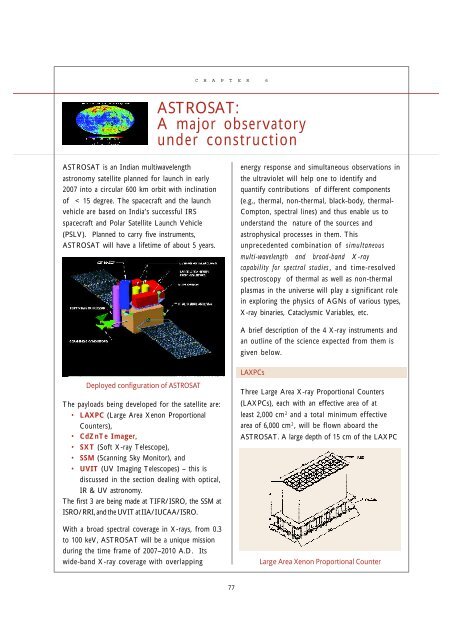2004 ASTRONOMY & ASTROPHYSICS - Indian Academy of Sciences
2004 ASTRONOMY & ASTROPHYSICS - Indian Academy of Sciences
2004 ASTRONOMY & ASTROPHYSICS - Indian Academy of Sciences
Create successful ePaper yourself
Turn your PDF publications into a flip-book with our unique Google optimized e-Paper software.
CHAPTER 6<br />
ASTROSAT:<br />
A major observatory<br />
under construction<br />
ASTROSAT is an <strong>Indian</strong> multiwavelength<br />
astronomy satellite planned for launch in early<br />
2007 into a circular 600 km orbit with inclination<br />
<strong>of</strong> < 15 degree. The spacecraft and the launch<br />
vehicle are based on India’s successful IRS<br />
spacecraft and Polar Satellite Launch Vehicle<br />
(PSLV). Planned to carry five instruments,<br />
ASTROSAT will have a lifetime <strong>of</strong> about 5 years.<br />
energy response and simultaneous observations in<br />
the ultraviolet will help one to identify and<br />
quantify contributions <strong>of</strong> different components<br />
(e.g., thermal, non-thermal, black-body, thermal-<br />
Compton, spectral lines) and thus enable us to<br />
understand the nature <strong>of</strong> the sources and<br />
astrophysical processes in them. This<br />
unprecedented combination <strong>of</strong> simultaneous<br />
multi-wavelength and broad-band X-ray<br />
capability for spectral studies, and time-resolved<br />
spectroscopy <strong>of</strong> thermal as well as non-thermal<br />
plasmas in the universe will play a significant role<br />
in exploring the physics <strong>of</strong> AGNs <strong>of</strong> various types,<br />
X-ray binaries, Cataclysmic Variables, etc.<br />
A brief description <strong>of</strong> the 4 X-ray instruments and<br />
an outline <strong>of</strong> the science expected from them is<br />
given below.<br />
LAXPCs<br />
Deployed configuration <strong>of</strong> ASTROSAT<br />
The payloads being developed for the satellite are:<br />
• LAXPC (Large Area Xenon Proportional<br />
Counters),<br />
• CdZnTe Imager,<br />
• SXT (S<strong>of</strong>t X-ray Telescope),<br />
• SSM (Scanning Sky Monitor), and<br />
• UVIT (UV Imaging Telescopes) – this is<br />
discussed in the section dealing with optical,<br />
IR & UV astronomy.<br />
The first 3 are being made at TIFR/ISRO, the SSM at<br />
ISRO/RRI, and the UVIT at IIA/IUCAA/ISRO.<br />
With a broad spectral coverage in X-rays, from 0.3<br />
to 100 keV, ASTROSAT will be a unique mission<br />
during the time frame <strong>of</strong> 2007–2010 A.D. Its<br />
wide-band X-ray coverage with overlapping<br />
Three Large Area X-ray Proportional Counters<br />
(LAXPCs), each with an effective area <strong>of</strong> at<br />
least 2,000 cm 2 and a total minimum effective<br />
area <strong>of</strong> 6,000 cm 2 , will be flown aboard the<br />
ASTROSAT. A large depth <strong>of</strong> 15 cm <strong>of</strong> the LAXPC<br />
Large Area Xenon Proportional Counter<br />
77
















